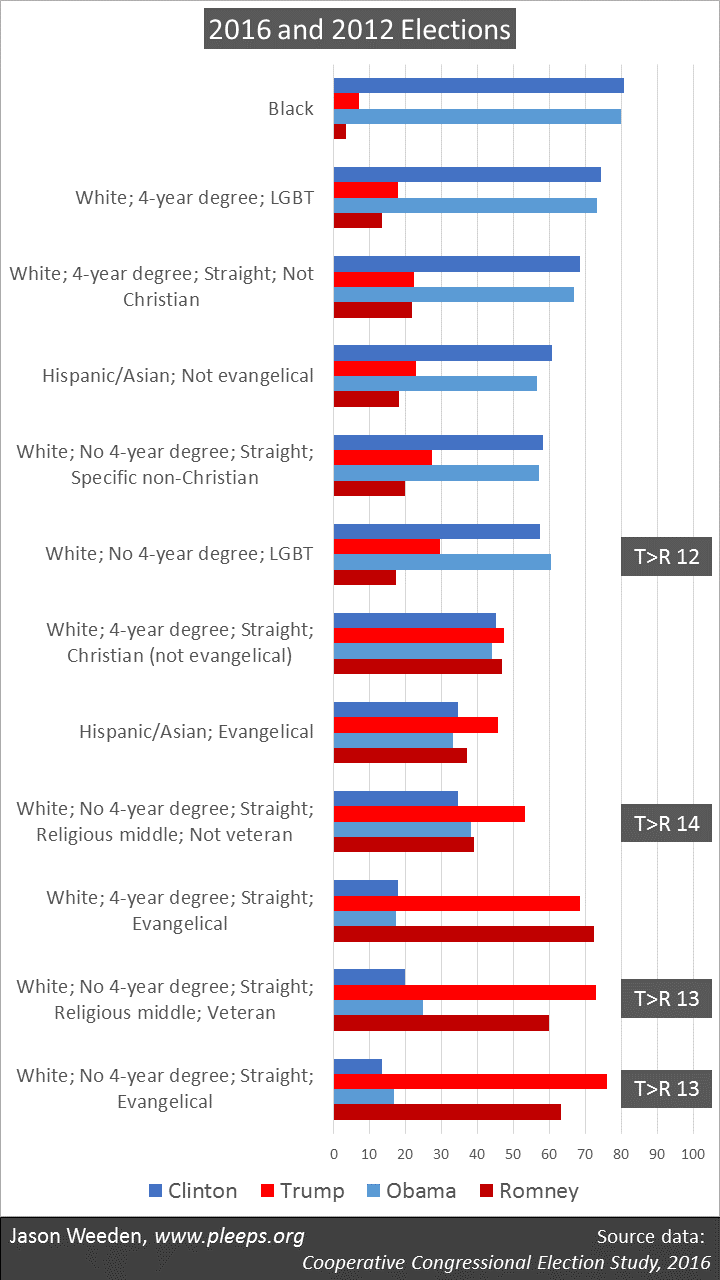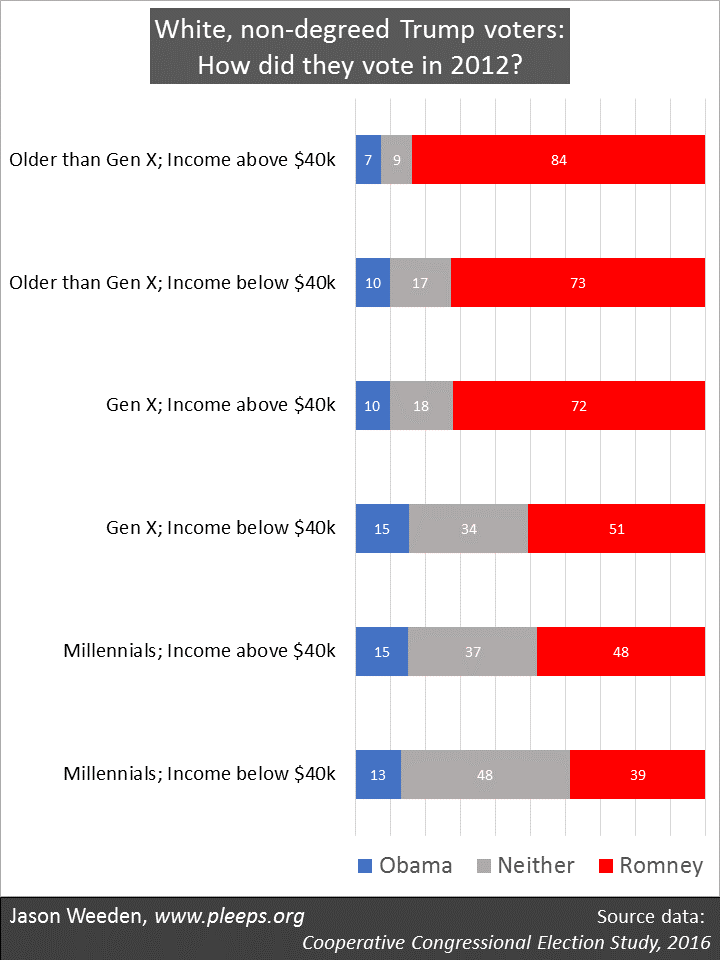I’ve been going through the 2016 Cooperative Congressional Election Study, which was released last week. So far, I’ve noted that the primary demographics dividing Clinton and Trump voters followed the familiar themes of race, religion, and sexual orientation, but that Trump also appears to have attracted substantial numbers of whites without college degrees who didn’t vote in 2012.
The chart below combines these points, using the same breakdown from my demographic post, but showing as well how the 2016 CCES respondents reported voting in the 2012 Obama/Romney election. The sample here is limited to those who were old enough to vote in 2012. It includes both voters and non-voters, which is why the percentage voting for the two major-party candidates often doesn’t come close to 100%—most of the rest were non-voters (but also including some third-party voters).
You can see that Clinton attracted a similar percentage of each group as Obama (that is, the two blue lines within each group are pretty similar), but that there were several groups where Trump attracted substantially bigger percentages than Romney. This was particularly true among the groups that consist of whites without 4-year college degrees. I’ve tagged the biggest ones in the chart (with the T>R boxes), groups in which the percentage voting for Trump exceeded the percentage voting for Romney by 12 to 14 points, even though Clinton had come up short of Obama in these groups by only 3 to 5 points—that is, Trump pulled a bunch of non-voters (or non-major-party voters) off the sidelines among whites without 4-year degrees.
 (Note: See the chart notes in my previous post for explanations of various terms.)
(Note: See the chart notes in my previous post for explanations of various terms.)
The Old Guard vs. the New Blood
The 2016 CCES is suggesting that, by pulling former non-voters into the mix, Trump expanded the Republican coalition without shrinking (much) the Democratic coalition. The Trump coalition, then, is one that adds new blood to an old guard.
So who are the old guard and the new blood? Specifically, among whites without 4-year degrees who voted for Trump (and who were old enough to vote in 2012), what are the major demographic differences between those who voted for Romney and those who didn’t?
The chart below shows two of the major differences. Primarily, among whites without 4-year college degrees who voted for Trump, those who are older and have higher incomes are substantially more likely to have also voted for Romney. For example, around 84% of Trump voters also voted for Romney among Baby Boomers and older folks with incomes above $40,000. Yet when we look at those who are young and poor—among white, non-degreed Trump voters who are Millennials with incomes below $40,000—only around 39% had voted for Romney (most of the rest didn’t vote at all, though, again, all these folks were old enough to vote in 2012).
And you may ask yourself, well, how did I get here?
Thus, as far as I can tell from the 2016 CCES data, the Trump coalition consists of a bunch of prior Republican voters plus a substantial new injection, many of whom are formerly sidelined non-degreed whites who are younger and have lower incomes.
Kurzban and I wrote The Hidden Agenda of the Political Mind between the 2012 and 2016 elections. Based primarily on General Social Survey data, we had spotted the pattern where lots of low-education and low-income whites weren’t voting (something that also shows up in the 2012 CCES data). Our diagnosis was that these folks were a relatively bad fit for the existing parties. In short, there were a lot of downscale whites who weren’t voting because they didn’t have candidates plausibly offering what they generally wanted—white nationalist priorities combined with left-leaning economic positions. We wrote (from p. 191):
“Is it any wonder, then, that so many downscale whites don’t vote? They typically favor robust income redistribution as well as group-based barriers. Democrats, on the one hand, favor income redistribution but oppose group-based barriers, and, worse, when push comes to shove, Democratic elites are more likely to protect human capital and cave on income redistribution. Republicans, on the other hand, oppose income redistribution and favor (some) group-based barriers; yet when push comes to shove, Republican elites are more likely to protect wealthy privilege and cave on group-based barriers. Unlike many European countries, the United States has no nationalist populist party that prioritizes the positions of downscale whites.”
Though we didn’t have a crystal ball, turns out that 2016 was their year. Trump campaigned on a platform of white nationalism (e.g., stressing a crackdown on immigrants and Muslims, favoring stop-and-frisk policing, and generally disdaining “political correctness”). And he combined it with an unorthodox mix of economic themes that emphasized working-class jobs (e.g., in manufacturing and the military) and gave assurances that he’d be gentle in altering redistributive policies (e.g., Trump’s promises that everyone would have great healthcare, that tax cuts wouldn’t be primarily for the rich, and that Social Security would be protected). He built it and they came.
Last in, first out?
So now a key question is whether these new Trump voters will stick around. Republicans are currently pushing an Obamacare replacement that would primarily give large tax cuts to the rich while reducing benefits for the poor. And Republicans see further tax cuts—again mostly for the rich—as another of their early priorities. And, not coincidentally, the drain in revenues created by these tax cuts will lead to further calls to reduce entitlements.
Will these kinds of legislative priorities end up returning significant numbers of Trump’s new blood to the electoral sidelines? Maybe, but it’s complicated. You’ve got to factor in that Trump is already giving his new voters something they wanted (i.e., a change in norms that permits more overt discrimination and reduces the influence of meritocrats), that cutting taxes for the wealthy doesn’t immediately affect working-class lives, that the current Republican plans schedule their Medicaid cuts to happen slowly over time, that there might yet be new infrastructure projects and a larger military to provide some new jobs targeted at working-class men, and so on. And then it’s never just about what one candidate or party offers, but rather it’s about the relative offers between competing candidates and parties. So, some of this depends on countermoves by Democrats, who continue to debate the electoral benefits and costs of adopting Sanders-style economic populism.
The picture of where we are and how we got here is coming into focus. Nevertheless, as the saying goes: Prediction is very difficult, especially about the future.

